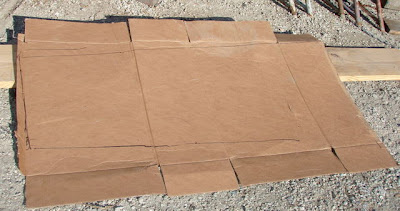Anchor Locker Repairs

A lot of our focus the last couple of weeks has been spent on repairing the anchor locker. Here I am grinding out around the cutwater to allow for a level place to weld the new pieces into.

Tamer, starting work on the Starboard stringers, with the port side already completed.

After a hard days work, both sides of stringers are now in and ready for the plates to be installed.

Tamer being the amazing genius that I love, came up with a brilliant plan for getting the new pieces of steel to fit into the holes. It started with holding a large piece of cardboard on the outside of the boat, while Valin traced the outline from the inside of the anchor locker. It was quite a challenge to fit the pieces for the simple fact that the bow of the boat is curved, and when the bad portion was removed with a cutting torch & saws-all, it did not leave a straight edge.

Matt and Tamer doing the final fitting of the cardboard template.

The outline......

The cutting......

Part of the struggle with this project was holding a 100 pound piece of steel in place, while it was fitted and spot welded. Tamer welded pieces of chain to the inside part of the steel, and this allowed Matt to manipulate it with a come-a-long from inside the anchor locker.

Teamwork.... How thankful we are for Matt's help with this task. This demonstrates how Matt was also able to use the come-a-long from the opposite hole as well as from the inside.

Tamer grinding the edges to insure a perfect fit.

"Almost done!!"

Tack welding the starboard side. What you don't see is Matt inside, sweltering, getting covered with sparks.

But, now you do :-)

Skip ahead about a week, and thankfully Raoul came to visit, and between the two of them they got the mill scale removed! A huge job!

What we realized later, is that because Raoul was on the starboard side, he was in the direct sunlight all afternoon, where as Tamer stayed nice and shady. An accident?? I think not :-) Just kiddin', thankfully Raoul is not prone to sunburn.

Wow! I'm kinda cute! If only that one eyebrow hair wasn't there...

After my Ospho application. We painted the next day, but I have not gotten a picture yet of it all white and shiny. Now we have to get out of denial about grinding / Osphoing / and painting coal tar epoxy on the inside. Hopefully next week!!


0 Comments:
Post a Comment
<< Home